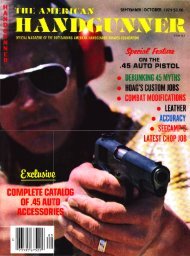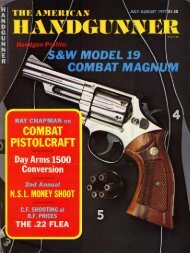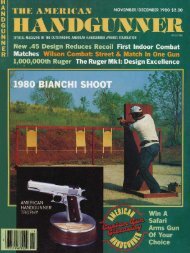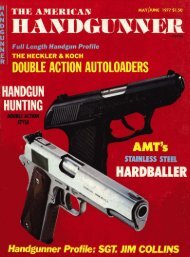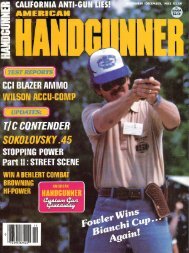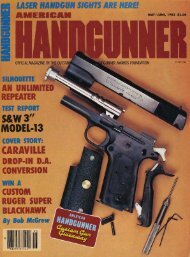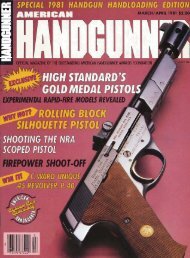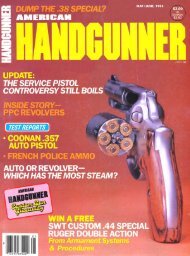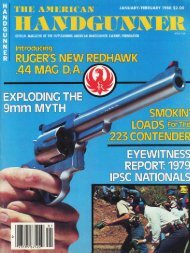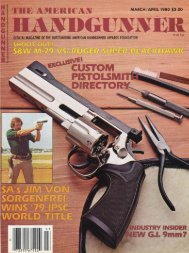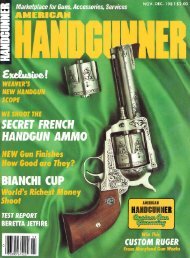March/April 1983 - American Handgunner
March/April 1983 - American Handgunner
March/April 1983 - American Handgunner
You also want an ePaper? Increase the reach of your titles
YUMPU automatically turns print PDFs into web optimized ePapers that Google loves.
known for his composite handgun gripsaninexpensive alternative to either rubberor expensive custom grips-and such IPSCaccessories as the Idaho Reloader, a superfastmagazine carrier; the Shok-Bujf, a tinyshock absorber that cushions the .45 framefrom the battering ofthe slide, and the E-ZLoad, a funnel that fits on the magazinewell of a .45 and facilitates loading.WILLINGNESS TO EXPERIMENTWhat has tied all Rogers' developmentstogether is a willingness to experiment andan unwillingness to be tied to the conventional.The patented Rogers compositeholster is a case in point."When I began Rogers Holsters, almostall holsters were designed with the sameconstruction;' said Rogers. "The holsterswere wet-fitted to a certain gun to get theirshape. The only problem was that leatherwill eventually absorb moisture, causingthe holster to lose its shape:'Rogers' solution was to design a holsterof synthetic material that held its shape,was impervious to moisture, still lookedgood, and was tough.When' the FBI was looking for a newholster to use at its academy, to be issuedwith the bureau's· then-standard Smith &Wesson MIO four-inch Special revolver,Rogers came up with the Model I paddleholster, which he patented when he was anagent. The FBI was so impressed with theholster that it ordered 400; Rogers Holsterswas off and running.Well, at least off and walking."No two ways about it," said Rogers."When we started out, it was tough."His holsters were made in a basementworkroom, with Rogers doing all the workhimself. When he wasn't filling orders,Rogers and wife, Christie, would travelaround the state of Florida-he haddecided to locate the business in Jacksonville,not far from his boyhood home ofOrlando-and show his holsters to policedepartments around the Sunshine State.Business prospered, largely becauseRogers was willing to listen to his customers,especially detectives. Finally, he wasinvited to participate in Miami's Departmentof Public Safety holster trials.Idaho reloader with combat magazine, for practical pistol shooting, top;a Ken Hackathorn Combat Special holster, center-left; one of Bill Rogers' newest high-ride combat holsters, center-right; and a Smith & Wesson N-framerevolver with Rogers "Burlwud" (a synthetic material) combat grips, boHom.TOUGH TESTSThe trials, he' says, tested not only thestamina of the holster but its safetyqualities as well."Recruits were used, and each had 30seconds to try and grab an unloaded revolverfrom another recruit's holster;' saidRogers. "After the first series of tests, Icould see something wasn't right, so I designeda second holster, which I redesignedsix times."No matter how tough the testing gQtandit got progressively tougher-theRogers holster kept functioning. After aone-month test, no other holsters werefound to be serviceable. Ofthe five Rogersholsters submitted, three were still func.tioning; the other two were still service-Continued on page 74AMERICAN HANDGUNNER· MARCH/APRIL <strong>1983</strong> 45



